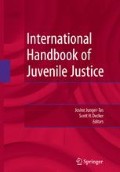Abstract
A quarter of a century ago, the prevailing view about how best to respond to juvenile1 crime was dominated by the orthodoxy that criminal justice interventions had little or no impact on future offending behaviour (and could even be counterproductive) and that juvenile justice policy should, as far as possible, focus on diverting young offenders from the criminal justice system (see, e.g., Morris and Giller, 1987). By the beginning of the 1990s, frustration with the scientific community’s reticence to endorse criminal justice interventions and public concern over the frequent offending of a relatively small group of young offenders led to an almost complete reversal of the diversion orthodoxy that characterised the 1980s. This was exemplified by the passing of the 1991 Criminal Justice Act, which moved towards a “just deserts” approach that shifted the focus of sentencing towards the nature and seriousness of the offence, rather than the offender and his/her criminal record.
Access this chapter
Tax calculation will be finalised at checkout
Purchases are for personal use only
Preview
Unable to display preview. Download preview PDF.
References
Allen, R. (1991). “Out of Jail: The Reduction in the Use of Penal Custody for Male Juveniles 1981–88,” Howard Journal, 30(1):30–52.
Allen, R. (2000) “New Approaches to Youth Justice” Criminal Justice Matters, 40:6–7.
Ashford, M. and Chard, A. (2000). Defending Young People in the Criminal Justice System. London: Legal Action Group 2000.
Audit Commission. (1996). Misspent Youth. Abingdon: Audit Commission Publications.
Audit Commission. (2004). Youth Justice 2004: A Review of the Reformed Youth Justice System. Wetherby: Audit Commission Publications.
Auld, L.J. (2001). Review of the Criminal Courts in England and Wales. London: HMSO.
Bateman, T. (2004). “Youth Justice News,” Youth Justice, 3(3):192–201.
Campbell, S. (2002). A Review of Anti-Social Behaviour Orders. Home Office Research Study No. 236. London: Home Office.
Coleman, C. and Moynihan, J. (1996). Understanding Crime Data: Haunted by the Dark Figure. Buckingham: Open University Press.
Crowley, A. (1998). A Criminal Waste. London: Children’s Society.
Family Policy Studies Centre. (1998). The Crime and Disorder Bill and the Family. London: Family Policy Study Centre.
Flood-Page, C., Campbell, S., Harrington, V., Mayhew, P., and Miller, J. (2000). Youth Crime: Findings from the 1998/99 Youth Lifestyles Survey. Home Office Research Study. London: HMSO.
Ghate, D. and Ramella, M. (2002). Positive Parenting. London: Youth Justice Board.
Ghose, D. (2004). Newspapers Give Young People a Bad Reputation. Young People Now. Haymarket, London, England.
Graham, J. (1990). “Decarceration in the Federal Republic of Germany: How Practitioners are Succeeding Where Policy-Makers have Failed,” British Journal of Criminology, 30(2):150–170.
Graham, J. (2002). “Juvenile Crime and Justice in England and Wales,” in N. Bala, J.P. Hornick, H.N. Snyder, and J.J. Paetsch (eds.), Juvenile Justice Systems: An International Comparison of Problems and Solutions. Toronto: Thompson Educational Publishing.
Graham, J. and Bowling, B. (1995). Young People and Crime. Home Office Research Study, No. 145. London: HMSO.
Hagell, A., Hazel, N., and Shaw, C. (2000). Evaluation of Medway Secure Training Centre. London: Home Office.
Hazel, N., Hagell, A., Liddle, M., Archer, D., Grimshaw, R., and King, J. (2002). Detention and Training: Assessment of the Detention and Training Order and its Impact on the Secure Estate across England and Wales. London: Youth Justice Board.
Little, M., Kogan, J., Bullock, R. and Van der Laan, P. (2004). ISSP: An Experiment in Multi-Systemic Responses to Persistent Young Offenders Known to Children’s Services. British Journal of Criminology. 44(2): 225–240.
Moore, S. (2000). “Child Incarceration and the New Youth Justice,” in B. Goldson (ed.), The New Youth Justice. Lyme Regis: Russell House Publishing, pp. 115–128.
Morgan Harris Burrows, (2003) Evaluation of the Youth Inclusion Programme. London: Youth Justice Board
Morris, A. and Giller, H. (1987). Understanding Juvenile Justice. Beckenham: Croom Helm.
NACRO. (2002). Differential Patterns of Custodial Sentencing. London: Youth Justice Board.
NACRO. (2003). Youth Crime Briefing: Anti-Social Behaviour Orders and Associated Measures (Part 1). London: NACRO.
Office for National Statistics (2004), People and Migration-Population, Where People Live. www. statistics.gov.uk; http://www.statistics.gov.uk/cci/nugget.asp?id=760; http://www.statistics.gov.uk/ cci/nugget.asp?id=1306.
PA Consulting Group. (2003a). The Content of Short DTOs Compared with ISSP. London: Youth Justice Board.
PA Consulting Group. (2003b). Repeat Young Offenders Arrested on Bail or Community Penalty. London: Youth Justice Board.
Smith, R. (2003). Youth Justice: Ideas, Policy, Practice. Willan Publishing.
Social Exclusion Unit. (2002). Reducing Reoffending by Ex-Prisoners. London: Social Exclusion Unit.
University of Oxford. (2002). Intensive Supervision and Surveillance Programmes: Evaluation Findings. Bulletin No 1, March 2002.
Author information
Authors and Affiliations
Editor information
Editors and Affiliations
Rights and permissions
Copyright information
© 2006 Springer
About this chapter
Cite this chapter
Graham, J., Moore, C. (2006). Beyond Welfare Versus Justice: Juvenile Justice in England and Wales. In: Junger-Tas, J., Decker, S.H. (eds) International Handbook of Juvenile Justice. Springer, New York, NY. https://doi.org/10.1007/978-0-387-09478-6_3
Download citation
DOI: https://doi.org/10.1007/978-0-387-09478-6_3
Publisher Name: Springer, New York, NY
Print ISBN: 978-0-387-09477-9
Online ISBN: 978-0-387-09478-6
eBook Packages: Humanities, Social Sciences and LawSocial Sciences (R0)

